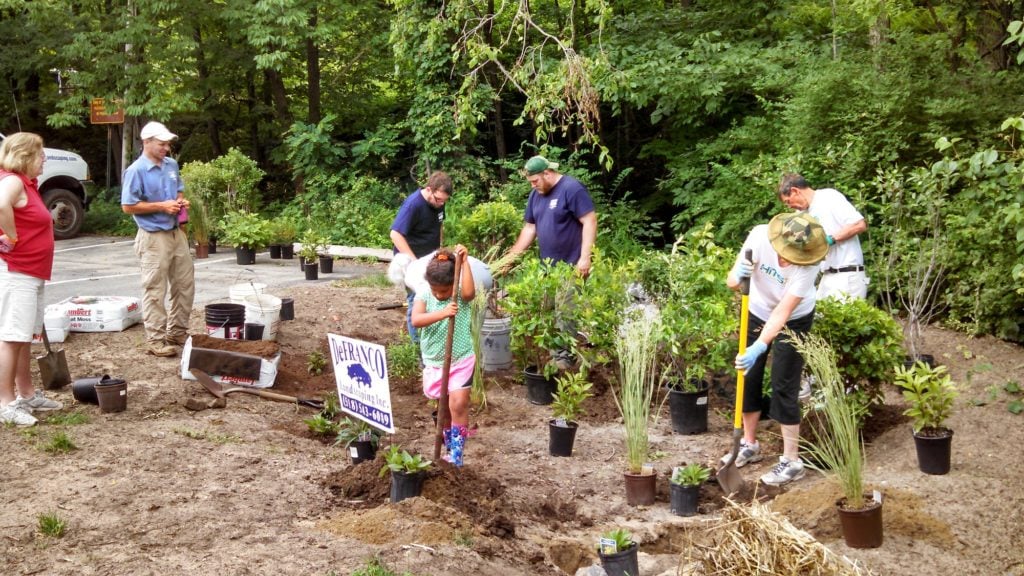At Lake George, Putting a “LID” on “Largest Water-Quality Problem”
By: Waterkeeper Alliance

When it rains on an urban landscape, it pours – pours a toxic mixture of Valvoline, Weed-be-Gone, Miracle-Gro, tire-dust, Lucky Strikes, dog poop and other components of pollution into storm-drains, sewers and, ultimately, our streams, rivers, lakes and bays.
Even if the water running through storm-drains were boiled, distilled, filtered, and sanitized before it rushes off paved streets and sidewalks rather than soaking into the ground, it would have picked up all of the above pollutants and more. Ordinary storms cause flash-floods that erode stream banks, stirring up sediments that deplete dissolved oxygen necessary for marine life. Mounting pressure on waterways from stormwater runoff is responsible for contaminant loading of chemicals, road salt, fertilizers, and more. And water that doesn’t enter the ground can cause a groundwater system to run on empty. The cooling springs that feed our neighborhood streams in summer run dry.
Nationwide, according to a report by the Natural Resources Defense Council, “an estimated 10 trillion gallons of untreated stormwater per year runs off roofs, roads, parking lots, and other paved surfaces, often through the sewage systems, into rivers and waterways that serve as drinking-water supplies, and flows to our beaches, increasing health risks, degrading ecosystems, and damaging tourist economies.” Because the exact origin of diffuse pollution from stormwater and snowmelt cannot easily be identified, it is exceedingly difficult to solve the problem through conventional regulation and controls.
In sum, stormwater is a major clean-water issue. In fact, the U.S. EPA has declared it “the nation’s largest source of water-quality problems.” Remediation calls for responsive innovation that, much like the problem itself, is distributed widely, and with the necessary consistency and coherent standards capable of controlling stormwater runoff at its many and varied sources.
Now Lake George Waterkeeper is onto an exciting solution. The Low Impact Development Certification System (LID), created by The FUND for Lake George, sponsor organization for Lake George Waterkeeper, is developing a powerful tool for managing stormwater runoff. Similar to LEED Certification for green buildings, LID rewards public and private property owners for taking prescribed steps to protect, build, restore, and maintain a property in ways that support lake health, applying proven methods of stopping runoff as close to its source as possible. Harnessing the momentum achieved in solving other threats to watershed health, including aquatic invasive species and road-salt migration, LID’s full implementation at Lake George will provide a working model for green-infrastructure planning and effective implementation throughout the Lake Champlain Basin and beyond.
“LID Certification incentivizes the restoration and maintenance of ecosystem services by promoting smart growth,” explains Lake George Waterkeeper Chris Navitsky, a licensed engineer. “We are not anti-development, we are anti-pollution. Low Impact Development balances growth and redevelopment with the protection and efficient use of resources, all for the benefit of our communities.”
Unlike ecological threats that are beyond individual or local control, stormwater runoff and pollution from built environments can be effectively managed within watersheds by LID because it mimics and, as much as possible, maintains natural drainage-patterns, site features, and hydrology to absorb, cleanse and filter stormwater. Properly applied, LID enables buildings, roads, and landscapes to “work more like a forest” when it rains, protecting watersheds and water quality. Leading by example, the LID Certification awards points for avoiding very steep slopes, maintaining shoreline buffers, protecting native trees of certain size and value, limiting impervious surfaces and lawn areas, providing natural stormwater treatment, and other techniques that naturally and effectively manage runoff.
“Such environmentally sound engineering practices and established techniques,” says Navitsky, “provide cost-effective means for property owners, developers, designers, engineers, public agencies, maintenance staff and others to readily mitigate stormwater runoff.”